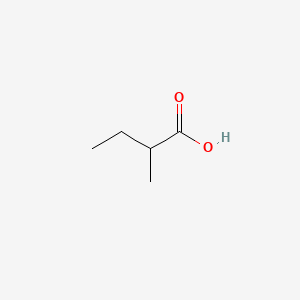| MeSH term | MeSH ID | Detail |
|---|---|---|
| Adenocarcinoma | D000230 | 166 associated lipids |
2-Methylbutanoic acid
2-Methylbutanoic acid is a lipid of Fatty Acyls (FA) class. The involved functions are known as Binding (Molecular Function), Oxidation, isoleucine catabolic process, Anabolism and physiological aspects. 2-methylbutanoic acid often locates in Membrane, soluble and host. The associated genes with 2-Methylbutanoic acid are Homologous Gene, Genome, NKS1 gene, HM13 gene and ACSM1 gene. The related lipids are Fatty Acids, Butyric Acids, branched chain fatty acid, Propionate and 2-methylvalerate.
Cross Reference
Introduction
To understand associated biological information of 2-Methylbutanoic acid, we collected biological information of abnormalities, associated pathways, cellular/molecular locations, biological functions, related genes/proteins, lipids and common seen animal/experimental models with organized paragraphs from literatures.
What diseases are associated with 2-Methylbutanoic acid?
There are no associated biomedical information in the current reference collection.
Possible diseases from mapped MeSH terms on references
We collected disease MeSH terms mapped to the references associated with 2-Methylbutanoic acid
PubChem Associated disorders and diseases
What pathways are associated with 2-Methylbutanoic acid
There are no associated biomedical information in the current reference collection.
PubChem Biomolecular Interactions and Pathways
Link to PubChem Biomolecular Interactions and PathwaysWhat cellular locations are associated with 2-Methylbutanoic acid?
Visualization in cellular structure
Associated locations are in red color. Not associated locations are in black.
Related references are published most in these journals:
| Location | Cross reference | Weighted score | Related literatures |
|---|
What functions are associated with 2-Methylbutanoic acid?
Related references are published most in these journals:
| Function | Cross reference | Weighted score | Related literatures |
|---|
What lipids are associated with 2-Methylbutanoic acid?
Related references are published most in these journals:
| Lipid concept | Cross reference | Weighted score | Related literatures |
|---|
What genes are associated with 2-Methylbutanoic acid?
Related references are published most in these journals:
| Gene | Cross reference | Weighted score | Related literatures |
|---|
What common seen animal models are associated with 2-Methylbutanoic acid?
There are no associated biomedical information in the current reference collection.
NCBI Entrez Crosslinks
All references with 2-Methylbutanoic acid
Download all related citations| Authors | Title | Published | Journal | PubMed Link |
|---|---|---|---|---|
| Giglio A et al. | Current knowledge on exocrine glands in carabid beetles: structure, function and chemical compounds. | 2011 | Zookeys | pmid:21738412 |
| Wu C et al. | Syntrophomonas wolfei subsp. methylbutyratica subsp. nov., and assignment of Syntrophomonas wolfei subsp. saponavida to Syntrophomonas saponavida sp. nov. comb. nov. | 2007 | Syst. Appl. Microbiol. | pmid:17223300 |
| Sun H et al. | Complete genome sequence of Desulfarculus baarsii type strain (2st14). | 2010 | Stand Genomic Sci | pmid:21304732 |
| Labutti K et al. | Permanent draft genome sequence of Dethiosulfovibrio peptidovorans type strain (SEBR 4207). | 2010 | Stand Genomic Sci | pmid:21304695 |
| Tanaka K et al. | Isovaleric and -methylbutyric acidemias induced by hypoglycin A: mechanism of Jamaican vomiting sickness. | 1972 | Science | pmid:5008580 |
| Kennedy J et al. | Modulation of polyketide synthase activity by accessory proteins during lovastatin biosynthesis. | 1999 | Science | pmid:10334994 |
| Høverstad T et al. | Influence of oral intake of seven different antibiotics on faecal short-chain fatty acid excretion in healthy subjects. | 1986 | Scand. J. Gastroenterol. | pmid:3775265 |
| Høverstad T et al. | Short-chain fatty acids in intestinal content of germfree mice monocontaminated with Escherichia coli or Clostridium difficile. | 1985 | Scand. J. Gastroenterol. | pmid:3890142 |
| Zhang A et al. | Sex pheromone of the pink hibiscus mealybug, Maconellicoccus hirsutus, contains an unusual cyclobutanoid monoterpene. | 2004 | Proc. Natl. Acad. Sci. U.S.A. | pmid:15197282 |
| Cherian G et al. | Dietary conjugated linoleic acid with fish oil alters yolk n-3 and trans fatty acid content and volatile compounds in raw, cooked, and irradiated eggs. | 2002 | Poult. Sci. | pmid:12412926 |
| Leahy SC et al. | The genome sequence of the rumen methanogen Methanobrevibacter ruminantium reveals new possibilities for controlling ruminant methane emissions. | 2010 | PLoS ONE | pmid:20126622 |
| Dalmasso M et al. | A temporal-omic study of Propionibacterium freudenreichii CIRM-BIA1 adaptation strategies in conditions mimicking cheese ripening in the cold. | 2012 | PLoS ONE | pmid:22253706 |
| Seemann A et al. | Variation of sesquiterpene lactone contents in different Arnica montana populations: influence of ecological parameters. | 2010 | Planta Med. | pmid:20101561 |
| Schilmiller A et al. | Mass spectrometry screening reveals widespread diversity in trichome specialized metabolites of tomato chromosomal substitution lines. | 2010 | Plant J. | pmid:20113441 |
| Alvarez-GarcÃa R et al. | Absolute configuration of the alpha-methylbutyryl residue in longipinene derivatives from Stevia pilosa. | 2005 | Phytochemistry | pmid:15771882 |
| Matich AJ et al. | Actinidia arguta: volatile compounds in fruit and flowers. | 2003 | Phytochemistry | pmid:12737978 |
| Socaci SA et al. | In-tube extraction and GC-MS analysis of volatile components from wild and cultivated sea buckthorn (Hippophae rhamnoides L. ssp. Carpatica) berry varieties and juice. | 2013 Jul-Aug | Phytochem Anal | pmid:23319448 |
| Dementyev P et al. | Chirally-modified metal surfaces: energetics of interaction with chiral molecules. | 2015 | Phys Chem Chem Phys | pmid:26256836 |
| Pareek A et al. | Feverfew (Tanacetum parthenium L.): A systematic review. | 2011 | Pharmacogn Rev | pmid:22096324 |
| Kølvraa S et al. | Studies of the glycine metabolism in a patient with D-glyceric acidemia and hyperglycinemia. | 1980 | Pediatr. Res. | pmid:7454444 |
